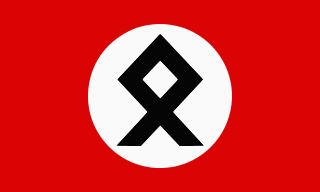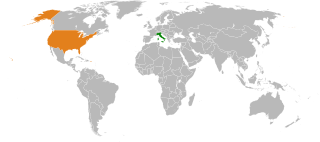Related Research Articles
Operation Gladio was the codename for clandestine "stay-behind" operations of armed resistance that were organized by the Western Union (WU), and subsequently by NATO and by the CIA, in collaboration with several European intelligence agencies during the Cold War. Although Gladio specifically refers to the Italian branch of the NATO stay-behind organizations, Operation Gladio is used as an informal name for all of them. Stay-behind operations were prepared in many NATO member countries, and in some neutral countries.

The Piazza Fontana bombing was a terrorist attack that occurred on 12 December 1969 when a bomb exploded at the headquarters of Banca Nazionale dell'Agricoltura in Piazza Fontana in Milan, Italy, killing 17 people and wounding 88. The same afternoon, another bomb exploded in a bank in Rome, and another was found unexploded in the Tomb of the Unknown Soldier. The attack was carried out by the far-right, neo-fascist paramilitary terrorist group Ordine Nuovo and possibly certain undetermined collaborators.

The National Vanguard is a name that has been used for at least two neo-fascist and neo-Nazi groups in Italy.

Stefano Delle Chiaie was an Italian neo-fascist terrorist. He was the founder of Avanguardia Nazionale, a member of Ordine Nuovo, and founder of Lega nazionalpopolare. He went on to become a wanted man worldwide, suspected of involvement in Italy's strategy of tension, but was acquitted. He was a friend of Licio Gelli, grandmaster of P2 masonic lodge. He was suspected of involvement in South America's Operation Condor, but was acquitted. He was known by his nickname "il caccola" as he was just over five feet tall - although he stated that originally, the nickname came from his very young involvement, at age 14, in the Italian Social Movement (MSI), a neo-fascist political party established after the war
Ordine Nuovo was an Italian far right cultural and extra-parliamentary political and paramilitary organization founded by Pino Rauti in 1956. It had been the most important extra-parliamentary neofascist organization of the post-war Italian republic.

A strategy of tension is a political policy wherein violent struggle is encouraged rather than suppressed. The purpose is to create a general feeling of insecurity in the population and make people seek security in a strong government.

Felice Casson is an Italian magistrate and politician, who discovered the existence of Operation Gladio, a "stay-behind" NATO anti-communist army during the Cold War, while investigating the Peteano bombing in 1972, for which two neo-fascists were convicted; the explosives used in the attack supposedly came from a NATO arms cache. 622 Gladio members, including two people who served as prime minister and president, were exposed in the course of the investigation.

Yves Guérin-Sérac, born Yves Guillou was a French anti-Communist Roman Catholic activist, former officer of the French army and veteran of the First Indochina War (1945–54), the Korean War (1950–53) and the Algerian War of Independence (1955–62). He was also a member of the elite troop of the 11ème Demi-Brigade Parachutiste de Choc, which worked with the SDECE, and a founding member of the Organisation armée secrète (OAS), a French terrorist group based in Spain which fought against Algerian independence in 1961-62. It was alleged that he was an instigator of the so-called strategy of tension in Italy, and the main organizer of the 1969 Piazza Fontana bombing.
Aginter Press, also known under the name Central Order and Tradition, was an international anti-communist mercenary organization disguised as a pseudo-press agency and active between 1966 and 1974. Founded in Lisbon, Portugal in September 1966 under António de Oliveira Salazar's Estado Novo, Aginter Press was directed by Captain Yves Guérin-Sérac, who had taken part in the foundation of the OAS in Madrid, a paramilitary group which fought against Algerian insurgents towards the end of the Algerian War (1954–1962). Aginter Press trained its members in covert action techniques, including bombings, silent assassinations, subversion techniques, clandestine communication and infiltration and counter-insurgency.
Guido Salvini is an Italian judge, based in Milan. He issued European arrest warrants in 2005 against approximatively 20 CIA agents accused of having taken part in the abduction of Abu Omar, the Egyptian cleric in Milan in 2003. The case is known in Italy as the Imam Rapito affair. Before that, Guido Salvini was in charge of investigations, since July 1988, concerning Italy's strategy of tension during the 1970s.
Projekt-26, best known as P-26, was a stay-behind army in Switzerland charged with countering a possible invasion of the country. The existence of P-26 as secret intelligence agencies dissimulated in the military intelligence agency (UNA) was revealed in November 1990 by the PUK EMD Parliamentary Commission headed by senator Carlo Schmid. The commission, whose initial aim was to investigate the alleged presence of secret files on citizens constituted in the Swiss Ministry of Defence, was created in March 1990 in the wake of the Fichenaffäre or Secret Files Scandal, during which it had been discovered that the federal police, BUPO, had maintained files on 900,000 persons.

In Italy, the phrase Years of Lead refers to a period of political violence and social upheaval that lasted from the late 1960s until the late 1980s, marked by a wave of both far-left and far-right incidents of political terrorism and violent clashes.
Guido Giannettini was an Italian secret agent.

Carlo Cicuttini was an Italian-born, naturalized Spaniard neofascist terrorist.
Piano Solo was an envisaged plot for an Italian anti-communist coup in 1964 requested by then president of the Italian Republic, Antonio Segni. It was prepared by the commander of the Carabinieri, Giovanni de Lorenzo, in the beginning of 1964 in close collaboration with the Italian secret service SIFAR, CIA secret warfare expert Vernon Walters, then chief of the CIA station in Rome William King Harvey, and Renzo Rocca, director of the Gladio units within the military secret service SID. It was named Solo because it was supposed to be directed only by the Carabinieri.

Italy and the United States enjoy warm and friendly relations. The United States has had diplomatic representation in the nation of Italy and its predecessor nation, the Kingdom of Italy, since 1840. However, in 1891 the Italian government severed diplomatic relations and briefly contemplated war against the US as a response to the unresolved case of the lynching of eleven Italians in New Orleans, Louisiana, and there was a break in relations from 1941 to 1943, while Italy and the United States were at war.
The Central Intelligence Agency (CIA) has been involved in Italian politics since the end of World War II. The CIA helped swing the 1948 general election in favor of the centrist Christian Democrats and would continue to intervene in Italian politics until at least the early 1960s.
Heinz Lembke was a German right-wing extremist and a member of the stay-behind network Gladio. Lembke was found hanged in his prison cell one day before his hearing by the federal prosecutor.

The Ordine Nero was an Italian terrorist fascist group founded in 1974 following the dissolution of the fascist Ordine Nuovo. Between 1974 and 1978, bombings by ON led to a number of woundings and deaths, having orchestrated several deadly bombings and murders including the 1974 Italicus Express Bombing and the 1974 Brescia Bombing.

The Peteano massacre was a neo-fascist terrorist attack which occurred on May 31, 1972 in Peteano, a frazione of Sagrado (Gorizia), Italy. An anonymous call led five carabinieri to check a suspicious car, which turned out to be a car bomb that exploded when the door was opened. Three carabinieri were killed.
References
- ↑ Clare Pedrick (November 14, 1990). "CIA Organized Secret Army in Western Europe". Washington Post .
- 1 2 Daniele Ganser (2005). "NATO's Secret Armies. Operation Gladio and Terrorism in Western Europe" (PDF). Whitehead Journal of Diplomacy and International Relations . London: Franck Cass: 3–4. Archived from the original (PDF) on 2014-08-05.
- 1 2 "Strage di Piazza Fontana spunta un agente USA". La Repubblica (in Italian). February 11, 1998. Retrieved February 20, 2007. (With original documents, including juridical sentences and the report of the Italian Commission on Terrorism).
- 1 2 Ed Vulliamy (December 5, 1990). "Secret agents, freemasons, fascists... and a top-level campaign of political 'destabilisation'". The Guardian .
- ↑ "Operation Gladio [BBC Timewatch, 1992] State-Sponsored Terror - YouTube". www.youtube.com. Archived from the original on 2021-12-21. Retrieved 2020-10-26.
- ↑ Elliott Gotkine (24 August 2004). "Vital rights ruling in Argentina". BBC News.
- ↑ Calloni, Stella (5 May 2000). "Arancibia, "clave" en la cooperación de las dictaduras" [Arancibia, "key" in the cooperation of the dictatorships]. La Jornada (in Spanish). Retrieved 27 April 2022.